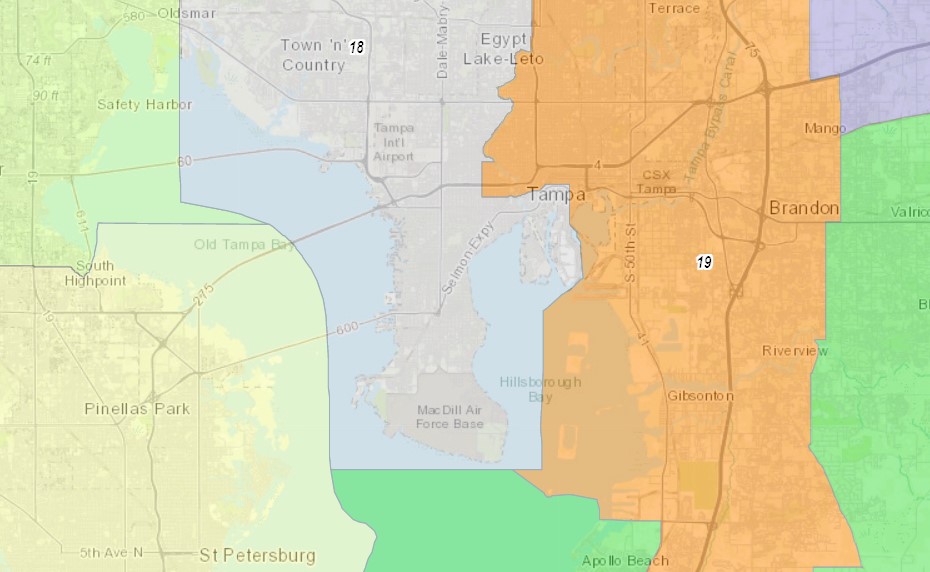
Could a Senate district now spanning Tampa Bay move east and exist entirely within Hillsborough County?
That’s not proposed on any of the initial draft maps produced by the Senate Reapportionment Committee staff. But Nicholas Warren, an ACLU attorney testifying at redistricting hearing, submitted his own proposed map of the Tampa Bay region that contains Senate District 19 in Hillsborough County. Warren woked on successful legal challenge against maps passed by the Legislature a decade ago.
That would have significant ramifications in the region and state, not the least of which includes that the district is now represented by Sen. Darryl Rouson, a St. Petersburg Democrat and long-time Pinellas County political leader. But on a larger scale, the district is one of Florida’s minority-controlled districts, meaning the political and demographic makeup of the district guarantees Black voters there can elect a candidate of their choice.
In the Senate staff drafts, about a third of the voting-age population in its version of SD 19 would be Black, and functional analysis shows greater power in that some 79% of Democrats in the district are Black, meaning that the community can elect a nominee in the blue district and guarantee representation in the Florida Senate.
Warren, though, said growth in Hillsborough County would allow the district to be contained in Hillsborough, normally a plus when it comes to legal scrutiny, and to still allow a Black candidate to win election. His draw on SD 19 leaves Black voters at just under 31% of voting-age residents.
No further functional analysis is yet available, but Jay Ferrin, staff director for the Senate Reapportionment Committee, said his team will look at Warren’s proposal.
The issue speaks to a broader balance senators want to achieve in protecting minority voices while holding as closely as possible to traditional geographic boundaries. The same Senate staff resisted calls in its draft congressional maps to have Florida’s13th Congressional District, a Pinellas seat held by Democratic U.S. Rep. Charlie Crist, cross Tampa Bay.
But Ferrin said concerns about minority representation prompted the map-drawing team to leave SD 19 straddling the major water body.
This district is just one example of the balance at the center of the once-a-decade redistricting process. When the Florida Supreme Court issued its ruling throwing out Senate and congressional districts approved by the Legislature a decade ago, justices made clear the Tier 1 and Tier 2 standards derived from Florida’s Fair Districts constitutional amendment and from the federal Voting Rights Act that must govern map-drawing.
Sen. Randolph Bracy, an Ocoee Democrat, at a Tuesday meeting of the Senate Legislative Reapportionment Subcommittee, pressed staff on what constitutes minority diminishment. Specifically, he questioned what’s happening with SD 19.
“It seems like it can be a gray area sometimes,” he told Florida Politics. “In the one district where I was talking about crossing the Bay, that district has gone up in Black population. But so you’re adding more Blacks to a district that already will be able to elect a Black candidate, and then that affects the next district of it being less likely to elect a Black candidate.”
Of note, the maps this year found a way to designate a majority Hispanic district in Central Florida, both in Senate and congressional drafts. Bracy noted, though, that those areas are already electing Hispanic representation. Senate District 15, the designated Hispanic district in Senate maps, is represented now by Orlando Democratic Sen. Victor Torres. Florida’s 9th Congressional District, to be a majority Hispanic district in Senate drafts, is represented today by U.S. Rep. Darren Soto.
Sen. Audrey Gibson, a Jacksonville Democrat on the Senate subcommittee, noted some of the drafts for Senate maps preserve majority Black districts in South Florida but produce lower percentages of the overall population.
“It seems like we are decreasing but still saying the community could elect a candidate of its choice,” she said. “I’d like to know how much diminishment of that percentage impacts that ability.”
Sen. Danny Burgess, the Zephyrhills Republican chairing the subcommittee, said he wanted all of that feedback to inform any changes to drafts that could be presented to the panel the next time it meets, in about two weeks.
“Consider these various tradeoffs in the maps,” he said.
As for what happens with SD 19, there’s considerable skepticism about how much the district should change in redistricting this year when the map district was created in the first place to guarantee Black representation in the Senate.
“We’re required to have that district,” said Sen. Kelli Stargel, a Lakeland Republican, “so I definitely think it’s important.”

___
Renzo Downey contributed to this report.



